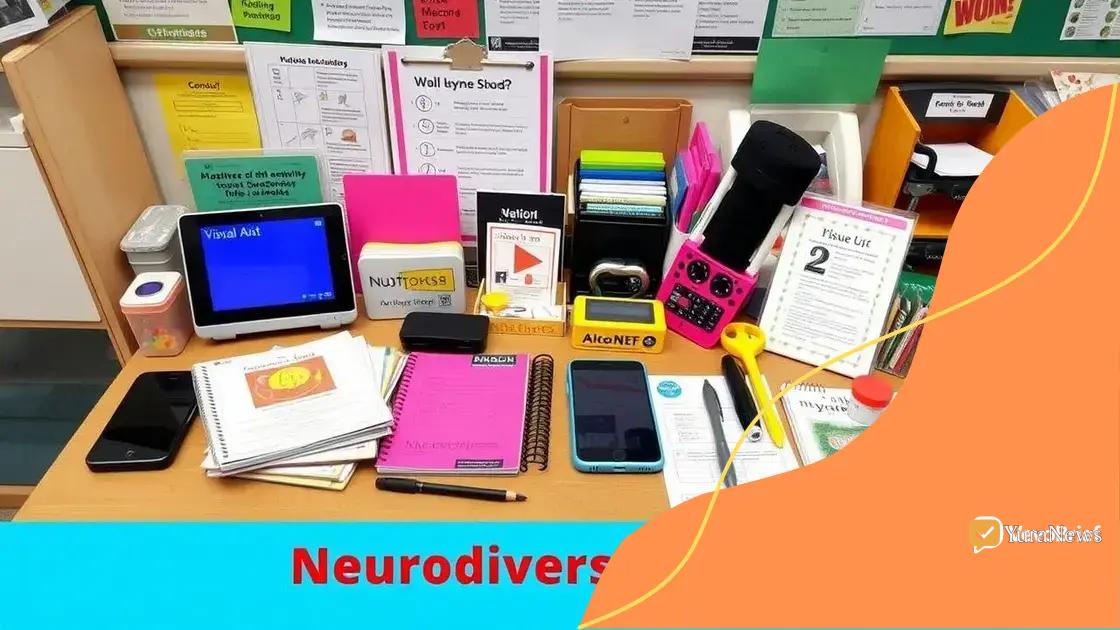Support for neurodiverse learners highlighted in education

Anúncios
Support for neurodiverse learners involves implementing effective teaching strategies, fostering a collaborative environment, and actively engaging parents and communities to enhance educational outcomes for all students.
Support for neurodiverse learners is crucial in shaping educational experiences that cater to diverse needs. Have you ever considered how different learning styles impact student performance? Let’s dive into strategies that can make a real difference in the classroom.
Anúncios
Understanding neurodiversity and its importance
Understanding neurodiversity is essential for appreciating the various ways that people think and learn. It includes conditions like autism, ADHD, and dyslexia, all of which embody unique strengths and challenges.
By recognizing neurodiversity, educators and peers can create an environment that values different perspectives. Let’s explore why this understanding is important in educational settings.
The significance of neurodiversity
Neurodiverse individuals often develop exceptional skills. For example, many individuals with autism have enhanced visual memory or detail orientation. Embracing these strengths boosts confidence and academic performance.
Anúncios
Creating supportive learning environments
To nurture neurodiverse learners, educators can adopt specific strategies:
- Offer flexible learning options tailored to different needs.
- Encourage open communication and feedback.
- Provide clear instructions and expectations.
- Incorporate assistive technologies to support diverse learning styles.
Such approaches not only enhance learning experiences but also help forge connections among students. When peers understand and accept each other’s differences, they foster a more inclusive classroom culture.
Moreover, educating the entire school community about neurodiversity can promote empathy and reduce stigma, creating a supportive atmosphere for all students.
Consequently, by prioritizing understanding and support for neurodiverse learners, we pave the way for a future where every student can thrive.
Effective teaching strategies for neurodiverse learners
Implementing effective teaching strategies for neurodiverse learners is vital for their academic success. Each student has unique needs and challenges, so tailoring approaches can help them thrive.
One key strategy is to use visual aids. Visual learning tools such as charts, diagrams, and videos can help clarify concepts for students who may struggle with traditional lectures. These tools can anchor learning and aid memory retention.
Flexible learning environments
Creating a flexible classroom environment is essential. By allowing students to choose their learning pathways, they can engage with the material in a way that suits them best. For instance, some may prefer group work while others excel in independent study.
- Provide options for assignments, like written, artistic, or digital formats.
- Create quiet spaces for students who need focus.
- Utilize technology that caters to different learning styles.
Additionally, consistent routines support neurodiverse learners. These students often benefit from knowing what to expect throughout the day. Clearly outlining the schedule and expectations can create a sense of comfort and stability. When students understand the routine, they can focus more on learning.
Engagement is equally important. Gamifying lessons can make challenging subjects more enjoyable. Incorporating games, quizzes, or interactive discussions can foster interest and participation among students who might otherwise disengage.
Lastly, building strong relationships with students is crucial. By understanding their individual strengths and challenges, educators can offer tailored support and encouragement. Regular check-ins show students that their well-being matters, which can motivate them to engage more fully in class.
Tools and resources to support neurodiverse students

Having the right tools and resources can significantly enhance support for neurodiverse students. Several options are available for educators to create an inclusive learning environment.
One effective type of resource is assistive technology. Tools like speech-to-text software and text-to-speech applications can aid students who struggle with reading or writing. These technologies help make learning more accessible and engaging.
Visual and organizational tools
Visual tools, such as graphic organizers, can assist students in structuring their thoughts. This is particularly beneficial for those who may have difficulty with traditional note-taking. Additionally, apps that offer visual schedules help students keep track of their daily activities and transitions, which can lessen anxiety.
- Checklists to help with task management.
- Mind mapping tools for brainstorming sessions.
- Online platforms that offer interactive learning modules.
Moreover, finding resources that align with individual learning styles is key. For instance, some students may benefit from hands-on learning activities, while others thrive in digital environments. Adjusting these resources to meet specific needs can lead to better outcomes.
Additionally, professional development for educators can be incredibly valuable. Training sessions that focus on understanding neurodiversity and implementing inclusive practices equip teachers with strategies to better support their students.
Parents also play a crucial role in accessing resources. Building strong home-school connections allows families to share insights about their children and collaborate on effective strategies. Schools that provide workshops or informational sessions on available resources create a stronger support network for both students and families.
Creating an inclusive classroom environment
Creating an inclusive classroom environment is essential for supporting neurodiverse learners. Students learn best when they feel valued and included, which contributes to a positive atmosphere.
Incorporating flexible seating can help meet the diverse needs of all students. Some may prefer to sit at desks, while others may thrive in a more relaxed environment, like bean bags or standing desks. Allowing choice in seating arrangements fosters comfort and focus during lessons.
Encouraging collaboration
Group activities also play a crucial role in an inclusive classroom. By encouraging students to work together, you can promote social interaction among peers. Cooperative learning enhances critical thinking and creates opportunities for neurodiverse students to shine.
- Implement peer mentoring programs.
- Use collaborative projects to enhance teamwork.
- Arrange seating to facilitate group discussions.
In addition, fostering a culture of respect is vital. Establishing classroom norms that prioritize kindness and understanding ensures that every student feels safe. Regularly discussing the value of diversity can encourage empathy among classmates.
Utilizing sensory tools is another great way to promote inclusivity. Items like fidget spinners or stress balls can help students manage anxiety and improve focus. Providing these tools shows that you recognize individual needs and support different learning styles.
Alongside these strategies, keeping open lines of communication with students is key. Invite feedback from students about what works for them. By actively listening to their needs, you can create an atmosphere where all learners thrive.
Engaging parents and communities in support efforts
Engaging parents and communities in support efforts for neurodiverse learners is crucial for fostering a collaborative and understanding environment. When schools partner with families, they can create a network of support that benefits all students.
One effective method is to organize informational workshops. These events can inform parents about the different needs of neurodiverse students and share effective strategies to help at home. Workshops can also provide resources to parents, empowering them to be active participants in their child’s education.
Building connections between home and school
Regular communication is key. Schools should establish open lines of communication through newsletters, emails, and parent-teacher conferences. This consistent feedback loop allows parents to share their observations and challenges, creating a stronger partnership between home and school.
- Establish a parent advisory committee focused on neurodiversity.
- Provide a platform for parents to share success stories and strategies.
- Host community events that welcome all families and promote inclusivity.
Additionally, community partnerships can enhance support efforts. Schools can collaborate with local organizations to provide resources like mental health services, tutoring, or mentoring programs. By involving community members, schools can bring diverse perspectives and expertise to support neurodiverse learners.
Promoting volunteer opportunities allows parents and community members to contribute to classroom activities or events. This not only fosters community spirit but helps build more supportive relationships among families, educators, and students.
Ultimately, when parents and communities are engaged, it sends a powerful message to neurodiverse students: their education and well-being are valued, making a lasting impact on their academic and social development.
FAQ – Supporting Neurodiverse Learners
What are the key benefits of an inclusive classroom environment?
An inclusive classroom fosters a sense of belonging, improves social skills, and helps all students feel valued, enhancing their overall learning experience.
How can parents get involved in supporting neurodiverse students?
Parents can participate in workshops, maintain open communication with teachers, and volunteer in activities that promote inclusivity.
What role does community support play in education?
Community support provides additional resources, mentorship opportunities, and collaborative efforts that enhance the educational experience for neurodiverse students.
What teaching strategies are effective for neurodiverse learners?
Effective strategies include using visual aids, flexible seating arrangements, and implementing varied teaching methods to accommodate different learning styles.